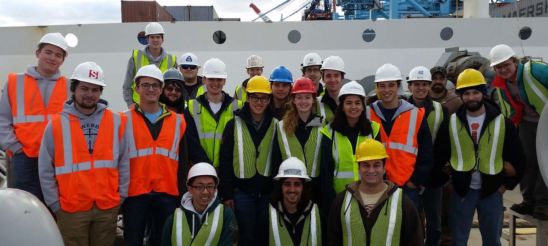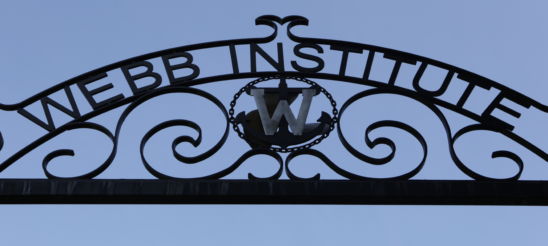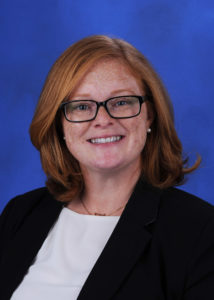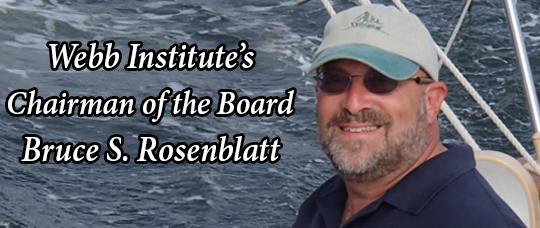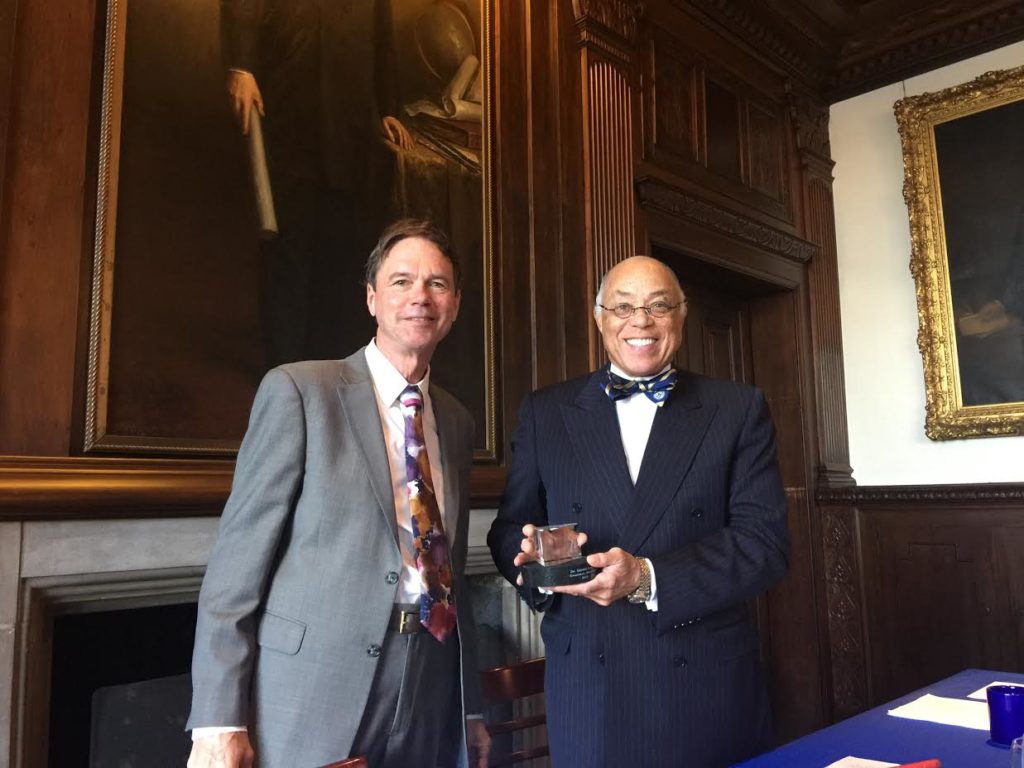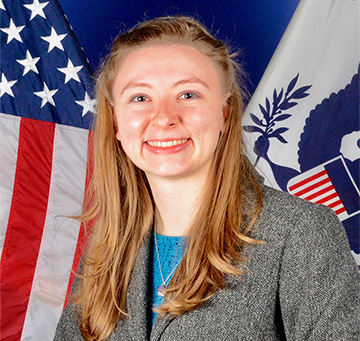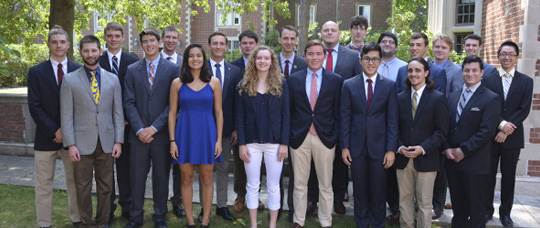Class of 2017 Tours the MAERSK DETROIT
On Friday December 2, 2016, Webb’s Class of 2017 toured the MAERSK DETROIT during its call in Newark, New Jersey.
During the tour, students had a lively discussion with the vessel’s master, who provided many insights on its desirable design features. The Seniors also had the opportunity to tour the deck and observe loading operations, cargo stowage methods, deck machinery layout and the steering gear.
Afterwards, students got to check out the engine control room where the First Assistant Engineer described the power plant and provided insight on the design and operation of the plant including the advantages of having an electronically-controlled main engine. Students also got to walk through the engine room where they could observe how the modern machinery plant was arranged.
Overall, the tour was a great experience for the students, and they appreciated the opportunity to tour a modern containership as they finish up their own containership designs for Webb’s Large Ship Design course.
Webb Alumna Helping Navy Build Better Ships
If you’d told Aurore (Rorie) Zuzick ’09 10 years ago that she would eventually represent the U.S. Navy on NATO’s Ship Design Capability Group Specialist Team, she wouldn’t have believed you.
“Who thinks that?” she laughed while reflecting on it. “I just wanted to make a small boat that you could easily repair, and I ended up here. My father was in the Air Force, my grandfathers were in the Navy, so the family was pro-DOD, but I hadn’t realized that I would go into the Navy world myself. But I’m very pleased I have.”
That’s the kind of opportunity that has become routine for Zuzick, who works as a naval architect in Carderock’s Full-Scale Trials Branch at Naval Surface Warfare Center, Carderock Division in West Bethesda, Maryland. She never predicted the smaller boats that were a daily part of her life growing up would lead to her conducting performance trials on the Navy’s massive, powerful ships.
“I grew up on Cape Cod, so we always did boating,” Zuzick said. “Sailing mostly, but rowing, too. Anything that floated, we were on it: put on a jacket and go play. It’s a total New England thing.”
Zuzick said she spent several summers working for a small boat dealership growing up, which involved rigging, fixing, assembling and repairing boats. This was the first time she became interested in learning about boat building, but her life wouldn’t head in that direction immediately. She spent her high-school years competitively snowboarding, which she returned to after she found a stint attending Massachusetts Institute of Technology not to her liking at the time and decided to try something else. At first, that meant moving out West and being a ski bum for three years before realizing she needed to return to what she loved. This meant becoming a “Webbie” by attending Webb Institute, a tiny school on Long Island, New York, that graduates 15 to 20 students a year in just one degree plan: naval architecture and marine engineering.
“There are a ton of Webbies in the Navy,” Zuzick said. “It’s a really small pool, but relative to Webb’s size, a lot of them end up working for the Navy, maybe half. In the small world of naval architecture, people get really excited when they meet another Webbie.”
At Webb, Zuzick found working on computational fluid dynamics (CFD) the most interesting and decided to pursue that her senior year.
“Water is very complicated. It’s a very challenging problem to solve. CFD is really a field that was enabled by big computers. It’s been growing, and it’s gotten more interesting, particularly back then [in the late 2000s],” Zuzick said. “I met another Webb alum and he told me, ‘If you want to do your senior year internship at Carderock, we can make that happen.’ I knew what Carderock was, but what initially drew my interest was CFD. The nerdy subject matter kind of got me in the door, and then when I learned about the quality of these facilities and the mission of the command, I was hooked.”
Zuzick’s main duties involve testing the ability of ships to perform certain activities safely in certain weather conditions. She usually works at West Bethesda and the Washington Navy Yard, but she also travels, sometimes to underway surface ships. She said doing that has definitely given new meaning to terms like “reliability metric.”
“You have to deal with what you have out there – it’s not about a PowerPoint slide. Your crew is not sleeping when they’re fixing something that’s broken. So you get a good reminder to have perspective on things like that when you have an opportunity to be at sea for a good little while,” Zuzick said. “We go out for one to three weeks and we’re out there working like crazy. You get to meet everybody, you get to ask questions and you get to learn about how your work affects the people in the fleet. That’s an important relationship you don’t get when you’re in the office all the time.
“These ships have to float, they have to go at the speed you want with the power you’ve given them, getting as far as they need to with the fuel they have, and so on, sometimes in really bad waves,” Zuzick continued. “It’s kind of a nutty jigsaw puzzle, but it’s interesting when you’ve got bugs to work out. You learn a lot from the process, and it’s really fun.”
Since coming aboard Carderock in 2009, Zuzick earned her master’s degree in mechanical engineering from the University of Maryland. She spent time last year as a member of the Leadership Education and Development (LEAD) Program, an unexpected opportunity she said she was grateful to Carderock Technical Director Dr. Tim Arcano for selecting her for the program. The LEAD Program was developed to provide high-performing, journey-level professionals at Carderock with the strategies and tools to lead across the division. Through the program, participants develop and strengthen their leadership skills and obtain a broader outlook of Carderock and Naval Sea Systems Command (NAVSEA) by participating in activities that range from book discussions to rotational assignments.
Zuzick said another perspective moment for her was bringing her family to October’s commissioning of the Navy’s newest and most technologically advanced warship, USS Zumwault (DDG 1000), in Baltimore. She said that she doesn’t often get a chance to step back and think about what she’s been a part of in this job, but seeing their reaction made that happen for her.
“They were over the moon; they were so impressed and it reminded me in turn that it really is very impressive and important,” Zuzick said. “Of course, a lot of other people did a heck of a lot more work with that ship than I have, but I’ve been working on it for pretty much the whole time I’ve been with the Navy, and it’s exciting just to say you’re doing something that benefits other people.”
Zuzick said when she isn’t working, she’s usually sailing with her husband, Travis, a boat builder in Annapolis whom she wed in September. But whether it’s with small boats in her spare time or surface ships at work, it’s a sure thing this Webbie will be working and playing on the water for a long time to come.
Naval Surface Warfare Center, Carderock Division, a part of Naval Sea Systems Command, leads the Navy in hull, mechanical and electrical engineering. Headquartered in West Bethesda, Carderock Division employs approximately 2,000 scientists, engineers, technicians and support personnel and includes detachments in Norfolk (Little Creek); Port Canaveral, Florida; Fort Lauderdale, Florida; Memphis, Tennessee; Bangor, Washington; Ketchikan, Alaska; and Bayview, Idaho.
Story provided by Dustin Q. Diaz, Naval Surface Warfare Center, Carderock Division Public Affairs
Bruce S. Rosenblatt Named New Chairman of the Board
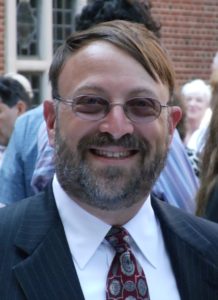 On Tuesday, October 18, 2016, Webb’s Board of Trustees appointed Bruce S. Rosenblatt as their new Chairman of the Board.
On Tuesday, October 18, 2016, Webb’s Board of Trustees appointed Bruce S. Rosenblatt as their new Chairman of the Board.
Rosenblatt, President of Bruce S. Rosenblatt & Associates, LLC, is a third-generation naval architect and marine engineer who has always shown a great love and support for Webb Institute and the role it plays in producing exceptional marine industry professionals, many of which he has hired.
“My grandfather started his marine industry career 109 years ago and there is nothing that brings me more pleasure than to continue that tradition by helping to assist the future of the marine industry. I can think of no finer place to do this than at Webb Institute.”
Dr. George Campbell Jr., who faithfully served as Chairman since 2012, will remain an active member of the Board.
“I am indebted to Dr. George Campbell for the outstanding mentorship and support he provided to me during my first three years serving as Webb’s president,” said President Keith Michel. “Bruce Rosenblatt brings a strong understanding and commitment to the maritime industries and the education of marine professionals. I have full confidence he will serve Webb with distinction and look forward to working with both Bruce and George in the coming years.”
Other Board appointments include Jon LaBerge ‘76 as Vice Chair of the Board, Greggory Mendenhall as Treasurer, and John Costello ’89 as Secretary. In addition, the Board welcomed a couple of new members: Peter K. Wallace ’93 as President of the Webb Alumni Association, and Eugene R. Miller ’96 of Bath Iron Works.
Webb Alumna Named 2017 Coast Guard Engineer of the Year
Webb Alumna, Sarah Wickenheiser ’08, has been named the 2017 Coast Guard Engineer of the Year! Her selection was based on her exemplary educational, professional, and personal achievements.
Wickenheiser, who serves as a staff engineer in the Hull Engineering Branch, provides technical engineering solutions to Yard projects. During the modification to the National Oceanic Atmospheric Administration (NOAA) Vessel Thomas Jefferson, she identified design deficiencies in the ship’s structure that could have resulted in catastrophic hull failure. Wickenheiser’s structural vulnerability analysis was used in the construction and addition of the new liquid storage tanks, allowing for a 50% improvement in vessel operating efficiency. Additionally, to avoid hull damage to the CGC EAGLE while drydocked for sequential shell plating renewal, she developed an innovative protocol using finite element analysis to validate segmented sections of EAGLE’s hull.
In addition to being a graduate of Webb, Wickenheiser is a Registered Professional Engineer in the State of Maryland and has served the Membership of the Society of Naval Architects and Marine Engineers (SNAME).
Webb congratulates Wickenheiser on this grand achievement and wishes her continued success!
Portion of text courtesy of SNAME
Class of 2017 Thesis Projects
Seaworthiness of an Autonomous Vessel: An Investigation of Viscous Effects on a SWATH in Roll-Inducing Waves
Andrew Arnold & Ian Cho
A SWATH geometry has been designed to serve as the hull of an autonomous vessel. It must have an appropriately limited roll response for the wave profile it will encounter in order to satisfy its mission. Our thesis tests this hull design in its must unfavorable roll condition, with beam seas exciting a response over a range of encounter frequencies. The vessel is tested at zero forward speed in both Webb’s Robinson Model Basin and the CFD program STAR-CCM+. In our experimentation, the vessel is free to move within six degrees of freedom so that measured responses are coupled and more accurately represent reality. The response equation is determined through these two methods and the results are compared and interpreted.
Testing of a Ducted Propeller with Varied Nozzle Geometry
Alexander Bashkoff & Tim Siepmann
This thesis consists of building a structural modification for the existing Webb Propeller Boat to allow for a nozzle to be supported around a propeller. We will verify our model by using a duct and propeller that MARIN previously tested, and then we will vary the size of the nozzle keeping the same Kaplan propeller to test for thrust efficiency. The structure is primarily aluminum, and the nozzles and propeller will be 3D-printed.
Modeling a Hydrogen-based, Renewable Energy Storage System in MATLAB and Simulink
Spenser Boyd
Renewable energy is becoming more common, but challenges exist in enabling renewables to become widespread and cost effective. Effective grid energy storage can relieve some of the challenges facing variable renewables and strengthen the grid as a whole. This thesis will design a hybrid hydrogen storage system and attempt to prove its feasibility through computer simulation and analysis in MATLAB/Simulink. The system will be modeled with realistic parameters, simulated under realistic operating conditions, and its performance evaluated. Additionally, a brief economic analysis will be performed to evaluate the feasibility of system implementation relative to other grid energy storage solutions. Read more…

